Socializing a puppy is vital. The socializing process determines how a puppy behaves along with its mental state. The training process of puppies leads them to become confident dogs who enjoy life. The early experience of interacting with various people together with animals and environments creates trust in dogs. Exposure to new environments during this stage helps puppies develop reduced anxiety and fear as adults. Socialize a puppy by following these steps.
Start Early
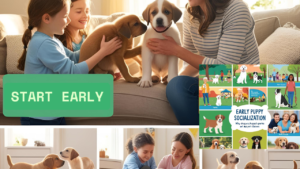
Your puppy should start socialization training following its arrival at your home. The optimum time for social exposure occurs when the puppy grows from 3 to 14 weeks old. The period between three and fourteen weeks represents when puppies easily learn from their experiences. They form positive associations quickly. Make use of this timeframe to present your puppy to the outside world.
Introduce New People

Let your puppy interact with numerous individuals. Invite friends and family over. Encourage individuals to hold down the puppy when they handle it and engage in games along with gentle petting. The socialization plan should include individuals who vary in terms of age groups in addition to size range and ethnic origins. The puppy develops positive views about human beings because of this experience. Each new meeting with people should result in a positive rewarding experience.
Expose to Various Sounds
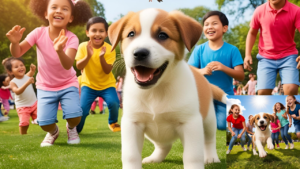
Strong noises in the environment cause puppies to become frightened. You should expose your puppy to everyday household noises while they are still young. Play recordings of traffic, fireworks, or thunderstorms at a low volume. Mostly increase noise levels through the time course of training. You should present the sounds during treat time or active interaction periods. Your puppy will remain relaxed during intense events because of this exposure.
Meet Other Dogs
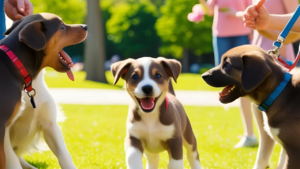
Puppies need dog friends too. Have play sessions between vaccinated dogs who display good behavior. The relationship should take place in an enclosed secure environment. Monitor their body language. Check for anxious or violent behavior. The interaction periods should stay brief yet upbeat. This builds good social habits.
Explore New Places

You should walk your puppy through various locations during his daily walks. Parks and sidewalks together with pet stores along with vet clinics make suitable locations. Your puppy should be permitted to discover the area by smell and sight. Treats function as awards for displaying courage. Through slow introduction experiences help the puppy develop familiarity with its environment.
Touch and Handling

Lend your puppy to accept physical contact. Touch their paws along with their ears and tail and mouth gently. Such training makes it easier for them to cooperate with grooming sessions and veterinary examinations. Make it fun and rewarding. Give praise and presents to your puppy following every touch. Practice daily for best results.
Use Positive Reinforcement

Always reward good behavior. Reward your puppy using snacks combined with praise and offering their cherished toy. Avoid punishment or yelling. This creates fear and stress. Reinforce calm and confident actions. The development of trust together with mental equilibrium emerges from a positive approach.
Keep Sessions Short

Don’t overwhelm your puppy. Short, frequent sessions work best. Determine brief sessions of 10–15 minutes which should happen a few times every day. You should end the training when your puppy indicates signs of fatigue or unease. Let them rest and recharge. Quality matters more than quantity.
Enroll in Puppy Classes

Structured puppy training programs provide an opportunity for social interactions between puppies. Experienced trainers lead the entire class under professional guidance. Through puppy training sessions puppies develop their ability to stay focused while interacting with dogs and human beings. Look specifically for training classes which adopt positive techniques. Do not choose training methods which employ abrupt disciplinary procedures.
Handle Fear with Care

Scared situations are normal for your puppy. That’s normal. Prevent your puppy from entering distressing conditions. Maintain proper boundaries during observation. Offer gentle encouragement. Reward any calm behavior. Gradually their self-esteem will increase through time.
Be Consistent

Consistency is key. You should present your puppy to new items at least once weekly. Repeat experiences in different settings. Introduce the puppy to children through visits in both public parks and personal residences. Ride in different cars. Visit new neighborhoods. The more variety, the better.
Involve the Whole Family

Community members from every resident living in the house need to participate. The entire training process should have identical commands and standardized training protocol. This avoids confusion. Each person connected to the puppy develops a stronger bond because of this experience. Maximal success through socialization happens when all members join the process.
Watch Body Language

You need to learn how to understand the signals which your puppy displays. Comfort signals include a wagging tail as well as relaxed ears and a playful bow. When your puppy shakes while showing threatening sounds or staying concealed it signifies fear. Respect your puppy’s limits. Go at their pace. Hard pressure can lead dogs to withdraw their interest.
Use Everyday Objects
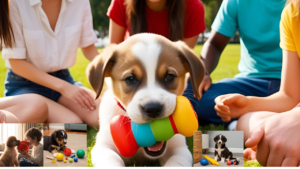
Permission for your puppy to handle routine items exists. Any item such as vacuum cleaners along with umbrellas hats and strollers might strike fear into a puppy. Let the puppy investigate these items by placing them in the examination area. Slow movement of items should be paired with treat offerings. The strategy allows your puppy to become comfortable with unfamiliar items.
Visit the Vet for Fun

You must take your pet to visit the veterinarian before he gets sick. The space is open for a pleasant introduction anytime. The staff should greet the puppy while allowing it to roam freely through the waiting area. Reward them with treats. These visits create positive memories. The clinic becomes less scary to the pet during actual veterinary appointments.
Practice Car Rides

Take short car rides often. Initiate your initial walks by touring only nearby streets. Gradually increase the time. Whenever your puppy remains calm during any behavior you should give them either praise or treats. The early habit-forming practice stops the development of travel anxiety as they grow older.
Avoid Negative Experiences
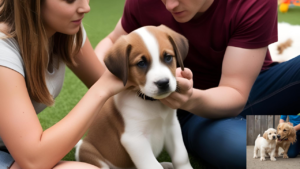
Try to avoid traumatic events. The experience will continue to affect your puppy if it leads to a bad memory. A bigger dog should never terrify your puppy during their interaction session. Unguarded areas with crowds and noise should be avoided unless your dog shows readiness. A single unpleasant experience can wipe away all the previous successful work.
Be Patient

Every puppy is different. Some are outgoing. Others are shy. Go at your puppy’s pace. Celebrate small wins. Learning to interact with others takes time over rushing through the process.
Monitor Progress
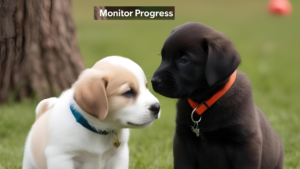
Track your puppy’s progress. Maintain a record which documents the new experiences you introduce to your puppy. Note their reactions. The tracking system assists your planning for upcoming sessions. The monitoring process enables you to spot development patterns throughout the duration.
When should I start socializing my puppy?
You should start socializing your puppy between 3 to 14 weeks of age, which is the critical socialization period.
What are the benefits of socializing a puppy?
Socialization helps your puppy become confident, calm, and mentally healthy. It reduces fear, anxiety, and aggression later in life.
How do I safely introduce my puppy to new dogs?
Use controlled playdates with vaccinated, friendly dogs. Watch their body language and keep interactions short and positive.
Can I socialize my puppy before vaccinations are complete?
Yes, but carefully. Avoid high-risk areas and focus on safe, clean environments or controlled indoor socialization.
What if my puppy is scared during socialization?
Don't force them. Give space, stay calm, and use gentle encouragement with treats and praise to build confidence.
How long should socialization sessions be?
Keep sessions short and frequent—about 10–15 minutes. Gradually increase time as your puppy becomes more confident.
Is it too late to socialize an older puppy?
It’s never too late, but early socialization is easier. With patience and consistency, older puppies can still learn.
Can puppy classes help with socialization?
Absolutely! Puppy classes offer safe, structured environments where your puppy can meet others and learn good behavior.
